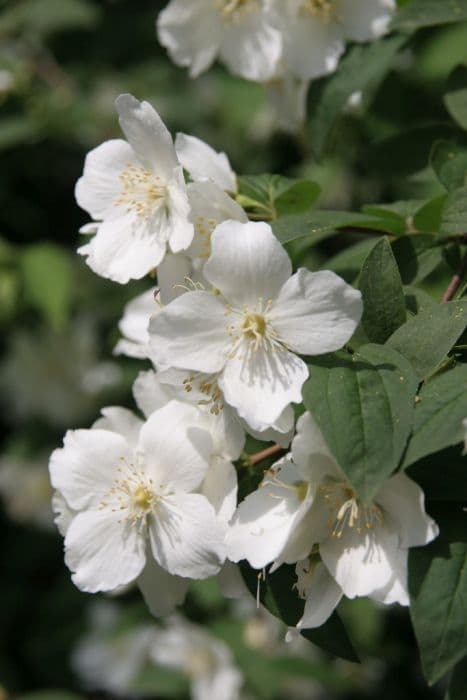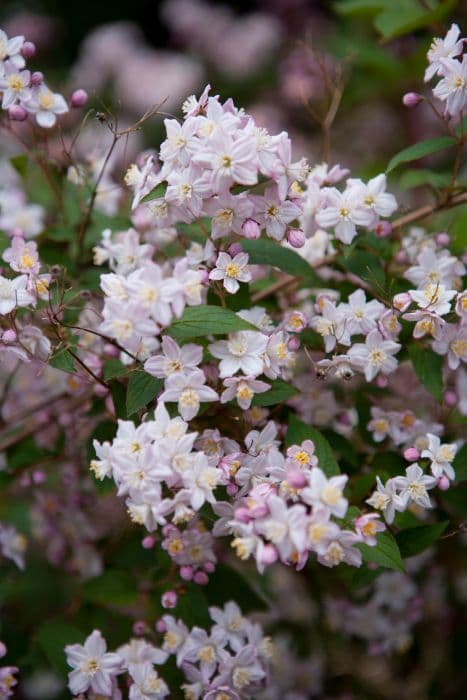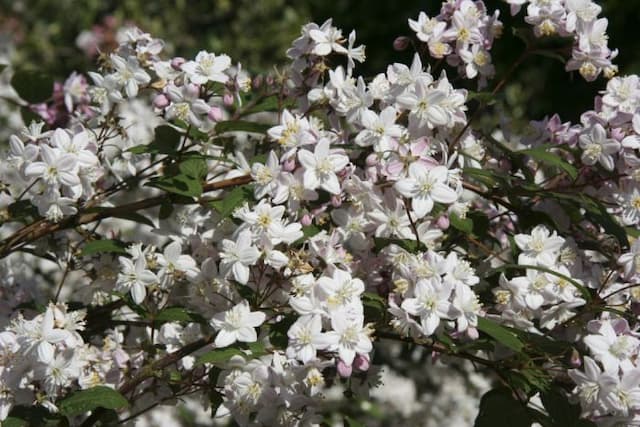Schrenk's Mock Orange Philadelphus schrenkii

ABOUT
The plant commonly known as Mock Orange is a captivating shrub that boasts a wealth of attributes contributing to its ornamental value. Its branches elegantly arch, creating an appealing, slightly cascading effect. The foliage of Mock Orange is a vibrant green, with leaves that possess a simple, oval to oblong shape, often coming to a gentle point. The leaf edges are finely toothed, adding to the delicate texture of the plant. Enveloping the Mock Orange in the blooming season are abundant, creamy-white flowers that exude a delightful, sweet fragrance reminiscent of orange blossoms, thus the name. These flowers are arranged in clusters and consist of four-petalled whorls, each petal broad and slightly rounded, cradling a prominent center of contrasting yellow stamens that lend a dash of brightness to the overall floral display. The blossoms are magnets for pollinators, such as bees, and provide a lush, romantic ambience. After the flowering period, the plant produces inconspicuous fruit which is generally not considered a significant ornamental feature. Together, the arching branches, refreshing green leaves, and fragrant white flowers make Mock Orange a cherished plant in gardens, serving as a splendid backdrop or a standalone specimen. The versatile nature of its appearance allows it to blend well with various other plants and garden styles, from informal cottage settings to more structured landscapes.
About this plant
 Names
NamesSynonyms
Schrenk's Mock Orange, Schrenk's Syringa
Common names
Philadelphus schrenkii Rupr., Philadelphus tenuifolius Rupr., Deutzia schrenkii (Rupr.) Maxim., Philadelphus discolor Maxim., Philadelphus pekinensis Rupr., Philadelphus tenuifolius var. discolor (Maxim.) Koehne.
 Toxicity
ToxicityTo humans
Philadelphus schrenkii, commonly known as Mock Orange, is not widely recognized as a poisonous plant to humans. Typically, it does not cause serious illness if ingested. However, as with many plants, individual sensitivities can vary. If symptoms do occur, they may be mild and could include gastrointestinal upset or skin irritation. Always exercise caution and keep any plant matter away from children, who may be more sensitive to plant compounds.
To pets
Mock Orange is not known to be toxic to pets either. It is not listed among plants that are commonly known to be poisonous to pets like dogs and cats. Therefore, ingestion of Philadelphus schrenkii should not cause serious harm to animals. However, as with humans, individual animals might have sensitivities, and ingestion could lead to mild gastrointestinal upset. To be safe, monitor pets around plants and discourage them from chewing on any type of ornamental shrubbery.
 Characteristics
CharacteristicsLife cycle
Perennials
Foliage type
Deciduous
Color of leaves
Green
Flower color
White
Height
6-10 feet (1.8-3 meters)
Spread
6-10 feet (1.8-3 meters)
Plant type
Shrub
Hardiness zones
5
Native area
Central Asia
Benefits
 General Benefits
General Benefits- Ornamental Value: The Philadelphus schrenkii, commonly known as Mock Orange, displays attractive white flowers that can enhance the beauty of gardens and landscapes.
- Fragrance: Mock Orange is renowned for its delightful fragrance that can perfume a garden area, making it a pleasurable experience to spend time outdoors.
- Habitat for Wildlife: The blossoms of Mock Orange provide nectar for pollinators such as bees and butterflies, supporting local ecosystems.
- Erosion Control: The plant's root system can help stabilize soil and prevent erosion in certain garden settings.
- Low Maintenance: This species is known for being hardy and relatively easy to care for, not requiring extensive gardening skills.
- Drought Tolerance: Once established, Mock Orange can tolerate periods of drought, making it suitable for xeriscaping and water-efficient gardening practices.
- Privacy Screen: With its dense foliage, Philadelphus schrenkii can serve as a natural privacy screen or hedge in landscape designs.
 Medical Properties
Medical Properties- Anti-inflammatory effects: Philadelphus schrenkii may be used in traditional medicine for its potential to reduce inflammation.
- Antioxidant properties: Some components of the plant may have antioxidant effects, which can help in protecting the body from oxidative stress.
- Diuretic potential: The plant might be used as a natural diuretic to help increase urine production and relieve fluid retention.
- Antipyretic use: It is sometimes used in folk remedies to reduce fever, though clinical evidence supporting this use is limited.
- Antispasmodic effects: Philadelphus schrenkii is occasionally credited with antispasmodic properties, potentially easing muscle spasms.
 Air-purifying Qualities
Air-purifying QualitiesThis plant is not specifically known for air purifying qualities.
 Other Uses
Other Uses- Philadelphus schrenkii, commonly known as Mock Orange, can be used as a natural fencing or hedging material due to its dense foliage.
- The wood of Mock Orange is sometimes used in small scale craftwork or carving, owing to its solidity and fine grain.
- Aromatic oil can be extracted from the flowers of Mock Orange, which is used in perfumery and aromatherapy for its sweet, citrus-like fragrance.
- The plant's branches can be used for creating rustic furniture or garden structures, such as trellises or arbors, because of their flexibility and strength.
- Mock Orange petals are sometimes used in potpourri mixes to add a fresh, floral scent to a room.
- The plant is utilized in landscape design for its ornamental value, particularly due to its abundant and fragrant blossoms.
- Culinary uses of the flowers include preparing floral syrups or infusions that mimic the scent of oranges.
- In craft projects, the dried flowers and leaves of Mock Orange can be incorporated into decorative wreaths or arrangements.
- Mock Orange can be used for educational purposes, such as plant identification and botanical studies, because of its distinct characteristics among deciduous shrubs.
- Photographers and painters sometimes use Mock Orange as a subject or backdrop for artistic compositions due to its aesthetic appeal.
Interesting Facts
 Feng Shui
Feng ShuiThe Mock Orange is not used in Feng Shui practice.
 Zodiac Sign Compitability
Zodiac Sign CompitabilityThe Mock Orange is not used in astrology practice.
 Plant Symbolism
Plant Symbolism- Innocence: The fragrant white flowers of the Mock Orange, which Philadelphus schrenkii is commonly known as, are often associated with purity and innocence, akin to that of the orange blossoms used in wedding traditions.
- Eternal Love: With its blooms that return reliably each spring, the Mock Orange is commonly thought to symbolize enduring or eternal love.
- Peace: The hushed, lush greenery and gently scented blossoms of the Mock Orange frequently evoke a sense of calm and peace.
- Memory: Sometimes plants such as the Mock Orange are planted in memory of loved ones, and their recurrent blossoms serve as a reminder of those who are no longer with us.
- Good Nature: The Mock Orange’s sweet fragrance and bright presence in a garden are often associated with good nature and a friendly disposition.
 Water
WaterThe Mock Orange (Philadelphus schrenkii) prefers consistent moisture, especially during its growing season in the spring and summer. Water the plant deeply once a week, providing about 1-2 gallons of water each time for a medium-sized shrub, ensuring the soil is moist but not soggy. During the hot summer months, the frequency may need to increase to twice a week if the weather is particularly dry or hot. In the fall and winter, reduce watering to every two weeks, or when the soil feels dry to the touch a few inches below the surface. Overwatering can lead to root rot, so it's important to check soil moisture before watering.
 Light
LightFor the Mock Orange (Philadelphus schrenkii), the best light conditions are full sun to partial shade. This means a spot that receives at least 4-6 hours of direct sunlight each day, but can tolerate some shade, especially in the afternoon when the sun is strongest. An eastern or western exposure would suit it well, providing the necessary light without the risks of scorching that can come with prolonged exposure to hot afternoon sun.
 Temperature
TemperatureMock Orange (Philadelphus schrenkii) thrives in temperate climates with temperatures ranging between 60 to 75 degrees Fahrenheit. It can survive minimum temperatures down to about 20 degrees Fahrenheit, but it’s important to protect the plant from frost. During the growing season, ensure the temperature stays within the ideal range for optimal growth.
 Pruning
PruningPrune Mock Orange (Philadelphus schrenkii) to maintain shape and encourage vigorous blooms. Pruning should be done right after flowering has finished, typically in late spring or early summer. Remove any dead or damaged branches and cut back up to one-third of the older stems to ground level to promote new growth. Pruning too late in the season can remove the buds for the next year's flowers.
 Cleaning
CleaningAs needed
 Soil
SoilMock Orange (Philadelphus schrenkii) thrives best in well-draining, loamy soil with a pH of around 6.5 to 7.5. The ideal soil mix for Mock Orange should comprise two parts loam, one part peat, and one part sand to ensure proper drainage and aeration. It's essential to avoid waterlogged conditions which can lead to root rot.
 Repotting
RepottingMock Orange (Philadelphus schrenkii) is a shrub that does not usually require frequent repotting. Repotting should be done every few years, or when the shrub outgrows its container. During the repotting process, ensure the new pot has ample room for root growth without being excessively large.
 Humidity & Misting
Humidity & MistingMock Orange (Philadelphus schrenkii) is tolerant of a wide range of humidity levels, but it does best in average humidity conditions. There is no specific humidity requirement, and common indoor levels are typically sufficient for this plant, making it relatively easy to care for in regards to humidity.
 Suitable locations
Suitable locationsIndoor
Place in bright, indirect light and water when topsoil feels dry.
Outdoor
Plant in sun to partial shade; water regularly to establish.
Hardiness zone
4-7 USDA
 Life cycle
Life cyclePhiladelphus schrenkii, commonly known as Mock Orange, begins its life cycle as a seed, typically requiring a period of cold stratification to break dormancy. Upon germination, the seedling emerges and develops into a young plant, establishing a root system and producing leaves. As it matures, the shrub enters a vegetative stage, growing stems and foliage in preparation for reproduction. Once mature, Mock Orange enters the flowering stage, producing fragrant white blooms that attract pollinators for sexual reproduction. After pollination, the flowers develop into small, inconspicuous fruit containing seeds, completing the cycle. The plant then either enters a period of dormancy during colder months or continues vegetative growth in milder climates.
 Propogation
PropogationPropogation time
Spring-early summer
Philadelphus schrenkii, more commonly known as the Sweet Mock Orange, is often propagated by softwood cuttings. This popular method is usually carried out in late spring to early summer when the plant's new growth is just beginning to mature and the stems are green and flexible. Cuttings about 4 to 6 inches (10 to 15 cm) long are snipped from a healthy Sweet Mock Orange, and the lower leaves are removed. The cut end is dipped in rooting hormone to encourage root growth and then inserted into a pot filled with a mix of peat and perlite to provide aeration and moisture retention. The pot is then kept in a warm, bright location but out of direct sunlight, and the soil is maintained slightly damp. Roots typically form within a few weeks, and once the cuttings are well-rooted, they can be transplanted into individual pots before eventually being moved to their final location in the garden.








![Hydrangea [Early Sensation]](/_next/image?url=https%3A%2F%2Fplants-admin.emdemapps.com%2Fimages%2Fplants%2F%2Fimages%2F604b6150338db.png&w=640&q=75)
